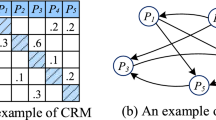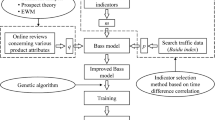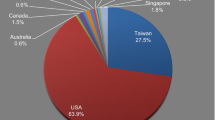Abstract
E-commerce companies want to predict their future product sales from the current customers’ feedback to frame a better business strategy. However, the conventional way of analyzing rating activities or quality and sentiment of reviews, volume of sales, or product prices is not enough for establishing a strong regression between these parameters and future product sales. Most of the existing works ignore the heterogeneous positional and influential effects of individual customer reviews and ratings. For the realization of these effects, we use review network i.e., a bipartite network between customers and products based on the customers’ review activities. In this paper, we present a concept named Network Promoter Score (NePS) based on the reliability, positional influence of each customer in the network. In-depth experiments on online review datasets show that NePS emerges as a strong indicator of product sales and can be remarkably futuristic compared to the existing parameters. Furthermore, we propose a predictive modeling technique to estimate the product sales of a company based on NePS.





Similar content being viewed by others
References
Abbasimehr, H., Shabani, M., & Yousefi, M. (2020). An optimized model using lstm network for demand forecasting. Computers & Industrial Engineering, 143, 106435. https://doi.org/10.1016/j.cie.2020.106435
Allison, P. D. (1999). Multiple regression: A primer. USA: Pine Forge Press.
Archak, N., Ghose, A., & Ipeirotis, P. G. (2011). Deriving the pricing power of product features by mining consumer reviews. Management Science, 57(8), 1485–1509. https://doi.org/10.1287/mnsc.1110.1370
Baek, H., Ahn, J., & Choi, Y. (2012). Helpfulness of online consumer reviews: Readers’ objectives and review cues. International Journal of Electronic Commerce, 17(2), 99–126. https://doi.org/10.2753/JEC1086-4415170204
Baek, H., Oh, S., Yang, H. D., & Ahn, J. (2017). Electronic word-of-mouth, box office revenue and social media. Electronic Commerce Research and Applications, 22, 13–23. https://doi.org/10.1016/j.elerap.2017.02.001
Bickart, B., & Schindler, R. M. (2001). Internet forums as influential sources of consumer information. Journal of Interactive Marketing, 15(3), 31–40. https://doi.org/10.1002/dir.1014
Brynjolfsson, E., Hu, Y., & Smith, M. D. (2003). Consumer surplus in the digital economy: Estimating the value of increased product variety at online booksellers. Management Science, 49(11), 1580–1596. https://doi.org/10.1287/mnsc.49.11.1580.20580
Chevalier, J., & Goolsbee, A. (2003). Measuring prices and price competition online: Amazon. com and barnesandnoble. com. Quantitative marketing and Economics, 1(2), 203–222. https://doi.org/10.1023/A:1024634613982.
Chevalier, J. A., & Mayzlin, D. (2006). The effect of word of mouth on sales: Online book reviews. Journal of Marketing Research, 43(3), 345–354. https://doi.org/10.1509/jmkr.43.3.345
Chintagunta, P. K., Gopinath, S., & Venkataraman, S. (2010). The effects of online user reviews on movie box office performance: Accounting for sequential rollout and aggregation across local markets. Marketing Science, 29(5), 944–957. https://doi.org/10.1287/mksc.1100.0572
Chua, A. Y., & Banerjee, S. (2015). Understanding review helpfulness as a function of reviewer reputation, review rating, and review depth. Journal of the Association for Information Science and Technology, 66(2), 354–362. https://doi.org/10.1002/asi.23180
Clemons, E. K., Gao, G. G., & Hitt, L. M. (2006). When online reviews meet hyperdifferentiation: A study of the craft beer industry. Journal of Management Information Systems, 23(2), 149–171. https://doi.org/10.2753/MIS0742-1222230207
Colladon, A. F., Guardabascio, B., & Innarella, R. (2019). Using social network and semantic analysis to analyze online travel forums and forecast tourism demand. Decision Support Systems, 123, 113075. https://doi.org/10.1016/j.dss.2019.113075
Das, S. R., & Chen, M. Y. (2007). Yahoo! for amazon: Sentiment extraction from small talk on the web. Management Science, 53(9), 1375–1388. https://doi.org/10.1287/mnsc.1070.0704
Dellarocas, C., Zhang, X. M., & Awad, N. F. (2007). Exploring the value of online product reviews in forecasting sales: The case of motion pictures. Journal of Interactive Marketing, 21(4), 23–45. https://doi.org/10.1002/dir.20087
Duan, W., Gu, B., & Whinston, A. B. (2008). Do online reviews matter? an empirical investigation of panel data. Decision Support Systems, 45(4), 1007–1016. https://doi.org/10.1016/j.dss.2008.04.001
DuBay, W.H. (2004). The principles of readability. Online Submission
Elkahky, A.M., Song, Y., & He, X. (2015). A multi-view deep learning approach for cross domain user modeling in recommendation systems. Proceedings of the 24th International Conference on World Wide Web (pp. 278–288) https://doi.org/10.1145/2736277.2741667
Eslami, S. P., & Ghasemaghaei, M. (2018). Effects of online review positiveness and review score inconsistency on sales: A comparison by product involvement. Journal of Retailing and Consumer Services, 45, 74–80. https://doi.org/10.1016/j.jretconser.2018.08.003
Eslami, S. P., Ghasemaghaei, M., & Hassanein, K. (2018). Which online reviews do consumers find most helpful? a multi-method investigation. Decision Support Systems, 113, 32–42. https://doi.org/10.1016/j.dss.2018.06.012
Fang, B., Ye, Q., Kucukusta, D., & Law, R. (2016). Analysis of the perceived value of online tourism reviews: Influence of readability and reviewer characteristics. Tourism Management, 52, 498–506. https://doi.org/10.1016/j.tourman.2015.07.018
Filieri, R., McLeay, F., Tsui, B., & Lin, Z. (2018). Consumer perceptions of information helpfulness and determinants of purchase intention in online consumer reviews of services. Information & Management, 55(8), 956–970. https://doi.org/10.1016/j.im.2018.04.010
Filieri, R., Galati, F., & Raguseo, E. (2021). The impact of service attributes and category on ewom helpfulness: An investigation of extremely negative and positive ratings using latent semantic analytics and regression analysis. Computers in Human Behavior, 114, 106527. https://doi.org/10.1016/j.chb.2020.106527
Fisher, N. I., & Kordupleski, R. E. (2019). Good and bad market research: A critical review of net promoter score. Applied Stochastic Models in Business and Industry, 35(1), 138–151. https://doi.org/10.1002/asmb.2417
Forman, C., Ghose, A., & Wiesenfeld, B. (2008). Examining the relationship between reviews and sales: The role of reviewer identity disclosure in electronic markets. Information Systems Research, 19(3), 291–313. https://doi.org/10.1287/isre.1080.0193
Fowdur, L., Kadiyali, V., & Narayan, V. (2009). The impact of emotional product attributes on consumer demand: An application to the us motion picture industry. Johnson School Research Paper Series (22-09), https://doi.org/10.2139/ssrn.1407520
Fu, D., Hong, Y., Wang, K., & Fan, W. (2018). Effects of membership tier on user content generation behaviors: evidence from online reviews. Electronic Commerce Research, 18(3), 457–483. https://doi.org/10.1007/s10660-017-9266-7
Ghose, A., & Ipeirotis, P. G. (2011). Estimating the helpfulness and economic impact of product reviews: Mining text and reviewer characteristics. IEEE Transactions on Knowledge and Data Engineering, 23(10), 1498–1512. https://doi.org/10.1109/TKDE.2010.188
Godes, D., & Mayzlin, D. (2004). Using online conversations to study word-of-mouth communication. Marketing Science, 23(4), 545–560. https://doi.org/10.1287/mksc.1040.0071
Godes, D., Mayzlin, D., Chen, Y., Das, S., Dellarocas, C., Pfeiffer, B., Libai, B., Sen, S., Shi, M., & Verlegh, P. (2005). The firm’s management of social interactions. Marketing Letters, 16(3–4), 415–428. https://doi.org/10.1007/s11002-005-5902-4
Goodfellow, I., Bengio, Y., & Courville, A. (2016). Deep learning. Cambridge: MIT Press. http://www.deeplearningbook.org.
Hansen, D.L., Shneiderman, B., Smith, M.A., & Himelboim, I. (2020). Chapter \(3\) - social network analysis: Measuring, mapping, and modeling collections of connections. In D.L. Hansen, B. Shneiderman, M.A. Smith, I. Himelboim (Eds), Analyzing social media networks with NodeXL, (2 edn, pp. 31–51). San Mateo: Morgan Kaufmann https://doi.org/10.1016/B978-0-12-817756-3.00003-0
He R., & McAuley J. (2016). Ups and downs: Modeling the visual evolution of fashion trends with one-class collaborative filtering. Proceedings of the 25th International Conference on World Wide Web (pp. 507–517), https://doi.org/10.1145/2872427.2883037
Hong, H., Xu, D., Wang, G. A., & Fan, W. (2017). Understanding the determinants of online review helpfulness: A meta-analytic investigation. Decision Support Systems, 102, 1–11. https://doi.org/10.1016/j.dss.2017.06.007
Hu, N., Koh, N. S., & Reddy, S. K. (2014). Ratings lead you to the product, reviews help you clinch it? the mediating role of online review sentiments on product sales. Decision Support Systems, 57, 42–53. https://doi.org/10.1016/j.dss.2013.07.009
Kang, Y., & Zhou, L. (2019). Helpfulness assessment of online reviews: The role of semantic hierarchy of product features. ACM Transactions on Management Information Systems (TMIS), 10(3), 1–18. https://doi.org/10.1145/3365538
Karimi, S., & Wang, F. (2017). Online review helpfulness: Impact of reviewer profile image. Decision Support Systems, 96, 39–48. https://doi.org/10.1016/j.dss.2017.02.001
Korfiatis, N., García-Bariocanal, E., & Sánchez-Alonso, S. (2021). Evaluating content quality and helpfulness of online product reviews: The interplay of review helpfulness vs. review content. Electronic Commerce Research and Applications, 11(3), 205–217. https://doi.org/10.1016/j.elerap.2011.10.003.
Korneta, P. (2018). Net promoter score, growth, and profitability of transportation companies. International Journal of Management and Economics, 54(2), 136–148. https://doi.org/10.2478/ijme-2018-0013
Li, L., Goh, T. T., & Jin, D. (2020). How textual quality of online reviews affect classification performance: a case of deep learning sentiment analysis. Neural Computing and Applications, 32(9), 4387–4415. https://doi.org/10.1007/s00521-018-3865-7
Li, X., Wu, C., & Mai, F. (2019). The effect of online reviews on product sales: A joint sentiment-topic analysis. Information & Management, 56(2), 172–184. https://doi.org/10.1016/j.im.2018.04.007
Lin, C. Y., Liaw, S. Y., Chen, C. C., Pai, M. Y., & Chen, Y. M. (2017). A computer-based approach for analyzing consumer demands in electronic word-of-mouth. Electronic Markets, 27(3), 225–242. https://doi.org/10.1007/s12525-017-0262-5
Liu, B. (2010). Sentiment analysis and subjectivity. Handbook of Natural Language Processing, 2(2010), 627–666.
Liu, Q., Zhang, X., Zhang, L., & Zhao, Y. (2019). The interaction effects of information cascades, word of mouth and recommendation systems on online reading behavior: An empirical investigation. Electronic Commerce Research, 19(3), 521–547. https://doi.org/10.1007/s10660-018-9312-0
Malik, M. S. I. (2020). Predicting users’ review helpfulness: The role of significant review and reviewer characteristics. Soft Computing, 1–16. https://doi.org/10.1007/s00500-020-04767-1
Mandal S., & Maiti A. (2018) Explicit feedbacks meet with implicit feedbacks: A combined approach for recommendation system. International Conference on complex networks and their applications (pp. 169–181) https://doi.org/10.1007/978-3-030-05414-4_14
Mandal, S., & Maiti, A. (2020). Explicit feedback meet with implicit feedback in GPMF: a generalized probabilistic matrix factorization model for recommendation. Applied Intelligence, 50(6), 1955–1978. https://doi.org/10.1007/s10489-020-01643-1
Maslowska, E., Malthouse, E. C., & Viswanathan, V. (2017). Do customer reviews drive purchase decisions? the moderating roles of review exposure and price. Decision Support Systems, 98, 1–9. https://doi.org/10.1016/j.dss.2017.03.010
McAuley, J., Targett, C., Shi, Q., & Van Den Hengel, A. (2015). Image-based recommendations on styles and substitutes. Proceedings of the 38th International ACM SIGIR Conference on research and development in information retrieval (pp. 43–52). ACM https://doi.org/10.1145/2766462.2767755
Netzer, O., Feldman, R., Goldenberg, J., & Fresko, M. (2012). Mine your own business: Market-structure surveillance through text mining. Marketing Science, 31(3), 521–543. https://doi.org/10.1287/mksc.1120.0713
Newman, M. (2018). Networks. Oxford: Oxford University Press.
Ni, J., Li, J., & McAuley, J. (2019). Justifying recommendations using distantly-labeled reviews and fine-grained aspects. Proceedings of the 2019 Conference on empirical methods in natural language processing and the 9th international joint conference on natural language processing (EMNLP-IJCNLP) (pp. 188–197) https://doi.org/10.18653/v1/D19-1018
Owen, R. (2019). Net promoter score and its successful application. In Marketing wisdom (pp. 17–29). Springer https://doi.org/10.1007/978-981-10-7724-1_2
Qiu, J., Lin, Z., & Li, Y. (2015). Predicting customer purchase behavior in the e-commerce context. Electronic Commerce Research, 15(4), 427–452. https://doi.org/10.1007/s10660-015-9191-6
Reichheld, F. F. (2003). The one number you need to grow. Harvard Business Review, 81(12), 46–55.
Ren, G., & Hong, T. (2019). Examining the relationship between specific negative emotions and the perceived helpfulness of online reviews. Information Processing & Management, 56(4), 1425–1438. https://doi.org/10.1016/j.ipm.2018.04.003
Rossi, P. E., Gilula, Z., & Allenby, G. M. (2001). Overcoming scale usage heterogeneity: A bayesian hierarchical approach. Journal of the American Statistical Association, 96(453), 20–31. https://doi.org/10.1198/016214501750332668
Salehan, M., & Kim, D. J. (2016). Predicting the performance of online consumer reviews: A sentiment mining approach to big data analytics. Decision Support Systems, 81, 30–40. https://doi.org/10.1016/j.dss.2015.10.006
Siering, M., Muntermann, J., & Rajagopalan, B. (2018). Explaining and predicting online review helpfulness: The role of content and reviewer-related signals. Decision Support Systems, 108, 1–12. https://doi.org/10.1016/j.dss.2018.01.004
Stouthuysen, K., Teunis, I., Reusen, E., & Slabbinck, H. (2018). Initial trust and intentions to buy: The effect of vendor-specific guarantees, customer reviews and the role of online shopping experience. Electronic Commerce Research and Applications, 27, 23–38. https://doi.org/10.1016/j.elerap.2017.11.002
Sun, X., Han, M., & Feng, J. (2019). Helpfulness of online reviews: Examining review informativeness and classification thresholds by search products and experience products. Decision Support Systems, 124, 113099. https://doi.org/10.1016/j.dss.2019.113099
Werbos, P. J. (1990). Backpropagation through time: what it does and how to do it. Proceedings of the IEEE, 78(10), 1550–1560. https://doi.org/10.1109/5.58337
Wu, Y., DuBois, C., Zheng, A.X., & Ester, M. (2016) Collaborative denoising auto-encoders for top-n recommender systems. Proceedings of the 9th ACM International Conference on web search and data mining (pp. 153–162) https://doi.org/10.1145/2835776.2835837
Xue, J., Liang, X., Xie, T., & Wang, H. (2020). See now, act now: How to interact with customers to enhance social commerce engagement? Information & Management, 57(6), 103324. https://doi.org/10.1016/j.im.2020.103324
Zhang, L., Aggarwal, C., & Qi, G.J. (2017). Stock price prediction via discovering multi-frequency trading patterns. Proceedings of the 23rd ACM SIGKDD International Conference on knowledge discovery and data mining (pp. 2141–2149) https://doi.org/10.1145/3097983.3098117
Zhang, Z., & Varadarajan, B. (2006). Utility scoring of product reviews. Proceedings of the 15th ACM International Conference on information and knowledge management (pp. 51–57) https://doi.org/10.1145/1183614.1183626
Author information
Authors and Affiliations
Corresponding author
Ethics declarations
Conflicts of interest
On behalf of all authors, the corresponding author states that there is no conflict of interest.
Additional information
Responsible Editor: Fabio Lobato
Rights and permissions
About this article
Cite this article
Mandal, S., Maiti, A. Network promoter score (NePS): An indicator of product sales in E-commerce retailing sector. Electron Markets 32, 1327–1349 (2022). https://doi.org/10.1007/s12525-021-00503-1
Received:
Accepted:
Published:
Issue Date:
DOI: https://doi.org/10.1007/s12525-021-00503-1




